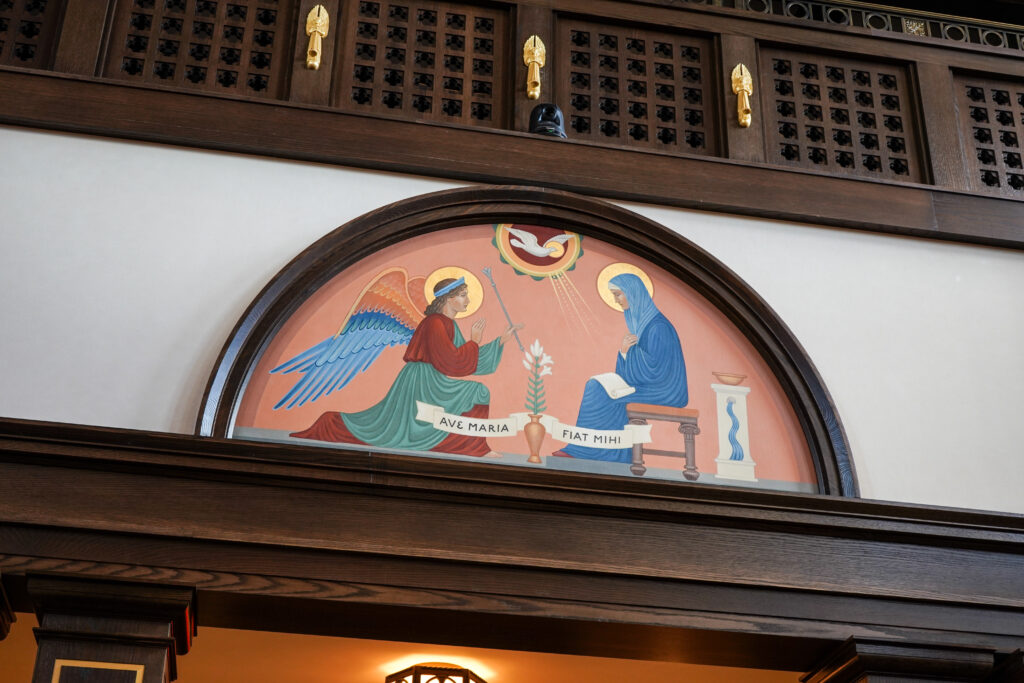Picking out an altar wasn’t in his job description, but Father Jonathan Kelly was incredibly grateful to have the opportunity anyway.
The rector at Saint John Vianney College Seminary, Kelly found himself in the middle of the Vetter Stone quarry in Mankato. Surrounded by countless multi-ton samples of Minnesota stone, a type of limestone, he’d need to choose just one to become the focal point of the seminary’s brand-new chapel. Thankfully, with a little help from the professionals, the choice was clear.
“The man said, ‘I think you got the best one on the lot’ and he said ‘this is my favorite stone,’” Kelly recalled. “For I don't know how many millions of years, but that stone has been in God’s providence waiting to become an altar.”
The stunning piece of Minnesota stone has since made its way to St. Paul, one of the chapel’s final finishing touches.
Dedicated by Archbishop Bernard Hebda on April 20, the new place of worship is the keystone of SJV’s 20,000-square-foot addition, which also includes priest staff residence space, offices and places to study.
Every inch of the expanded facility was designed with its seminarians in mind, but especially the chapel, where Kelly hopes countless new generations will be called to serve.
“I’m so grateful when people walk in here and their first reaction is one of transcendence and awe,” Kelly said. “This chapel is a place where the men will be able to hear God’s voice and will be strengthened to say yes to his call.”
Years of planning went into the chapel’s meticulous design process. While the new spaces were needed to solve the seminary’s most basic of problems (after 55 years they were running out of room), they also wished for the chapel to connect with seminarians through art and architecture.
Countless artisans and craftspeople were called upon to leave their creative mark on the space, contributing more than 150,000 hours of work. Below are a few highlights.
The altar

Even after the journey from Mankato, the beauty of the altar stone is still very much on display, but it’s been enhanced on the front by art. The altar itself is meant to represent Christ, which is why artisans were asked to create symbols of Christ in an intricate Lamb of God mosaic.
Meanwhile, on the inside of the support structure lies a first-class relic of the chapel’s namesake: St. John Vianney. Also sealed inside the altar is a leather scroll inscribed with the names of each benefactor who made the building project possible.
Chapel’s crucifix and supporting rood beam

High above the altar, a large beam with a statue of Jesus’ crucifixion bears the inscription “You are my beloved son, in whom I am well pleased” in Latin from the Gospel of Mark.
“That is what God the Father says to Jesus on two occasions in his life, in the Baptism and in the Transfiguration,” Kelly said. “That is our own inheritance as well. And so when you walk in here, my hope is that when guests arrive, they would be drawn into the love of God the Father and that elicits a response with their lives.”
Loaves and fishes mosaic

A replica of the “loaves and fishes” mosaic that hung behind the altar in SJV’s old chapel has been placed in the chapel floor of the new one where seminarians, staff and visitors receive Holy Communion.
“We thought this would be a very relevant and fitting place for the mosaic as you come up and receive Communion where we offer God our lives and He gives it back in a superabundant way,” Kelly said. “And so we bring our five loaves and our two fish, which is entirely inadequate to feed the 5,000, but Jesus makes it more than enough.”
Blessed Virgin Mary and St. Joseph statues

In a nod to the chapel’s predecessor, Nazareth Hall, 100-year-old statues from that space were given special placement in this new one. Statues of St. Joseph and the Blessed Virgin Mary, which had adorned a back room of the seminary for decades, were dusted off and installed to the left and right of the altar.
“We designed the niches just for them and so the way that Mary and Joseph are positioned there, it looks like they are almost in motion, that they want to step out to accompany us and minister to us,” Kelly said. “I love these statues. We just had to clean them and touch them up a little bit.”
Annunciation mural

The last thing you see when you exit the chapel is a mural of the Annunciation, which is where God, through the angel Gabriel, asks Mary if she’ll be the mother of God. The angel asks Mary if she will give God a human nature in Jesus, her Son, and she says yes.
For Father Kelly, it’s an incredibly appropriate image as seminarians and visitors head out into the world.
“That’s our inspiration as we leave the chapel every day,” Kelly said. “To hear God’s voice and to always say yes, the way that Mary did.”







